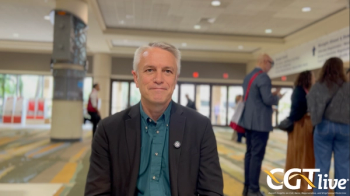
Amifostine Reduces Chemoradiation Toxicities, and Improves Response
SAN FRANCISCO-Amifostine (Ethyol) reduced acute pneumonitis and severe esophagitis while significantly increasing the complete response rate in patients receiving chemoradiation for inoperable stage II or III non-small-cell lung cancer (NSCLC) during a randomized phase III study. Hypotension was significantly more frequent among those receiving amifostine, although only one patient discontinued therapy because of a hypotensive episode.
SAN FRANCISCOAmifostine (Ethyol) reduced acute pneumonitis and severe esophagitis while significantly increasing the complete response rate in patients receiving chemoradiation for inoperable stage II or III non-small-cell lung cancer (NSCLC) during a randomized phase III study. Hypotension was significantly more frequent among those receiving amifostine, although only one patient discontinued therapy because of a hypotensive episode.
"The quality of life for these patients who received amifostine was much better, and I think that’s very important," said Ritsuko Komaki, MD, professor of radiation oncology at M.D. Anderson Cancer Center in Houston, Texas. By adding amifostine to the regimen, she explained, the investigators hoped to protect normal tissue from toxic effects of concurrent treatment, so that quality of life and, ultimately, outcomes could be improved.
Giving concurrent chemotherapy and radiation therapy in twice-daily fractionation had increased 5-year survival to 25% from 10% to 19% with sequential chemotherapy followed by daily radiation, according to Dr. Komaki. Despite these gains, she said the investigators had reached a plateau beyond which very aggressive, concurrent chemotherapy and radiation therapy had not improved 2-year or 5-year survival. "The major problem was the majority of patients, 62%, had grade 3 or 4 toxicity with weight loss or severe pain when they swallowed," she said.
Protective Properties
The researchers focused on amifostine, a free thiol (WR-1065), because it has protective properties inside healthy cells. It scavenges oxygen-free radicals from ionizing radiation and certain chemotherapeutic agents before they can damage normal tissue such as esophageal mucosa, lung, bone marrow, and kidneys, Dr. Komaki explained.
The trial randomized 60 patients, none with prior radiation, chemotherapy, or uncontrolled mucositis. One group received 500 mg of amifostine intravenously for 5 minutes twice weekly before chemoradiation69.6 Gy of thoracic radiation therapy plus oral etoposide (VePesid) and cisplatin (Platinol). The control group received the same chemoradiation regimen but without amifostine.
The researchers were able to evaluate 53 patients who had a minimum follow-up of 1 month: 27 patients ages 53 to 69 (median age 63.5) in the amifostine group and 26 patients ages 52 to 74 (median age 66) in the control group. Complete response was seen in 26% (7/27) of the amifostine arm, but only 7% (2/26) of the controls. The amifostine arm also had better median survival times: 26 months vs 15 months.
The toxicities targeted in the trial declined significantly for the patients given amifostine. Only two patients (7.4%) required morphine for severe esophagitis compared to eight patients (31%) in the control group. Only one patient on amifostine had acute pneumonitis (3.7%), but it occurred in six members (23%) of the control arm.
Antiangiogenesis Effect?
The main drawback to amifostine was hypotension, which was significantly more frequent for the amifostine arm. Nineteen patients (70%) receiving amifostine had a 20 mm Hg decline from baseline blood pressure. One patient stopped treatment because of a hypotensive episode. Only one person (3.4%) in the control group experienced hypotension.
The trial also documented less reduction in lung function (DLCO) 6 months after treatment for the amifostine group, compared to the control group: 24% vs 42% respectively. "The patients who had amifostine seemed to have less distant metastasis. It might have some antiangiogenesis effect," she added, noting that the patients will be followed through 2- and 5-year survival.
The investigators concluded that further study of long-term efficacy and possible cytotoxicity is needed. They reported that a randomized trial to further reduce toxicities has been developed.
Newsletter
Stay at the forefront of cutting-edge science with CGT—your direct line to expert insights, breakthrough data, and real-time coverage of the latest advancements in cell and gene therapy.



































